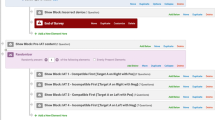Abstract
Social desirability responding (SRD) on surveys administered on the World Wide Web (WWW) and on paper was examined using 178 graduate and undergraduate students randomly assigned to a 2 (World Wide Web and Paper) ×2 (Anonymous and Nonanonymous) true experimental design. The findings reveal no differences in SDR between the WWW and the paper-administered survey conditions, and no differences in SDR between the anonymous and nonanonymous conditions. These findings and potential explanations are examined for consideration by anyone interested in using the WWW to obtain accurate information from survey participants.
Similar content being viewed by others
References
American Association of Collegiater Registrars and Admissions Officers. (1984).A guide to postsecondary institutions for implementation of the Family educational rights and privacy act of 1974 as amended/prepared by Task force, the Family Education Rights and Privacy Act of 1974 “Buckley amendment.”Washington, DC:The Association.
Berg, I.A. (1967). The deviation hypothesis: A broad statement of its assumptions and postulates. In I.A. Berg (ed.)Response set in personality assessment (pp. 146–190), Chicago: Aldine.
Bernreuter, R.G. (1933). Validity in personality inventory.Personality Journal, 11, 383–386.
Booth-Kewley, S., Edwards, J.E., & Rosenfeld, P. (1992). Impression management, social desirability, and computer administration of attitude questionnaires: Does the computer make a difference?Journal of Applied Psychology, 77(4), 562–566.
Booth-Kewley, S., Rosenfeld, P., & Edwards, J.E. (1993). Computer-assisted surveys in organizational settings: Alternatives, advantages, and applications. In P. Rosenfeld, J.E. Edwards, & M.D. Thomas (Eds.),Improving organizational surveys: New directions, methods, and applications (pp. 73–101). New-bury Park, CA Sage.
Calsyn, R.J. (1999). Understanding and controlling response bias in needs assessment studies.Evaluation Review, 23(4), 399–418.
Calsyn, R.J., & Klinkenberg, W.D. (1995). Response bias in needs assessment studies.Evaluation Review, 19(1), 217–225.
Clark, J.P., & Tifft, L.L. (1966). Polygraph and interview validation of self-reported deviant behavior.American Sociological Review, 31, 516–523.
Cronbach, L.J. (1946). Response sets and test validity.Educational and Psychological Measurement, 6, 475–494.
Crowne, D.P., & Marlowe, D. (1960). A new scale of social desirability independent of psychopathology.Journal of Consulting Psychology, 24, 349–354.
Dillehay, R.C., & Jernigan, L.R. (1970). The biased questionnaire as an instrument of opinion change.Journal of Personality and Social Psychology, 15, 144–150.
Doherty, L., & Thomas, M.D. (1986). Effects of an automated survey system upon responses. In O. Brown, Jr., & H.W. Hendrick (Eds.),Human factors in organizational design management II (pp. 157–161). North Holland, The Netherlands: Elsevier Science.
Eisman, R. (1991). Big brother lives.Incentive, 165, 21–27.
Feinstein, S. (1986, October 9). Computers replacing interviewers for personnel and marketing tasks.Wall Street Journal, p. 35.
Feuer, D. (1986). Computerized testing: A revolution in the making.Training, 23, 80–86.
Hamilton, D.L. 1968. Personality attributes associated with extreme response style.Psychological Bulletin, 69, 192–203.
Iadipaolo, D.M. (1992). Monster or monitor?Insurance and Technology, 17, 47–54.
Jacobson, L.I., Kellogg, R.W., Cauce, A.M., & Slavin, R.S. (1977). A multidimensional social desirability inventory.Bulletin of the Psychonomic Society, 9, 109–110.
Kiesler, S. & Sproull, L. (1986). Response effects in the electronic survey.Public Opinion Quarterly, 50, 401–413.
Knudson, D.D., Pope, H., & Irish, D.P. (1967). Response differences to questions on sexual standards.Public Opinion Quarterly, 31, 290–297.
Lautenschlager, G.J., & Flaherty, V.L. (1990). Computer administration of questions: More desirable or more social desirability?Journal of Applied Psychology, 75, 310–314.
Leak, G.K., & Fish, S. (1989). Religious orientation, impression management, and self deception: Toward a clarification of the link between religiosity and social desirability.Journal for Scientific Study of Religion, 28, 355–359.
Martin, C.L., & Nagao, D.H. (1989). Some effects of computerized interviewing on job applicant responses,Journal of Applied Psychology, 74, 72–80.
Meehl, P.E., & Hathaway, S.R. (1946). The K factor as a suppressor variable in the Minnesota Multiphasic Personality Inventory.Journal of Applied Psychology, 30, 525–564.
Mellor, S., Conroy, L., & Masteller, B.K. (1986). Comparative trait analysis of long-term recovering alcoholics.Psychological Reports, 58, 411–418.
Moorman, R.H., & Podsakoff, P.M. (1992). A meta-analytic review and empirical test of the potential confounding effects of social desirability response sets in organizational behavior research.Journal of Occupational and Organizational Psychology, 65(3), 131–150.
Paulhus, D.L. (1984). Two-component models of social desirability responding,Journal of Personality and Social Psychology, 46, 598–609.
Paulhus, D.L. (1991). Measurement and control of response bias. In J.P. Robinson, P.R. Shaver, & L.S. Wrightsman (Eds.),Measures of personality and social psychological attitudes (pp. 17–59). San Diego: Academic Press.
Paulhus, D.L. (1993).Assessing self-deception and impression management in self-reports: The Balanced Inventory of Desirable Responding-Reference manual for Version 6. Unpublished manual.
Paulhus, D.L., & Reid, D.B. (1991). Enhancement and denial in social desirability responding.Journal of Personality and Social Psychology, 60(2), 307–318.
Peabody, D. 1962. Two components in bipolar scales: Direction and extremeness.Psychological Review, 69, 65–73.
Phillips, D.L., & Clancey, K.J. (1972). Some effects of social desirability in survey studies.American Journal of Sociology, 77, 921–940.
Quinn, B.A. (1989).Religiousness and psychological wellbeing: An empirical investigation, Unpublished dissertation, Wayne State University, Detroit.
Ray, J.J. (1983). Reviving the problem of acquiescent response bias.Journal of Social Psychology, 121, 81–96.
Rosenfeld, P., Booth-Kewley, S., Edwards, J.E., & Thomas, M.D. (1996). Responses on computer surveys: Impression management, social desirability, and the Big Brother Syndrone.Computers in Human Behavior, 12(2), 263–274.
Rosenfeld, P., Doherty, L., Vicino, S.M., Kantor, J., & Greaves, J. (1989). Attitude assessment in organizations: Testing three microcomputer-based survey systems.Journal of General Psychology, 116, 145–154.
Rosenfeld, P., Giacalone, R.A., & Riordan, C.A. (1995).Impression management in organizations: Theory, measurement, practice, London: Routledge.
Sigall, H., & Page, R. (1971). Current stereotypes: A little fading, a little faking.Journal of Personality and Social Psychology 18, 247–255.
Sproull, H.L., & Kiesler, S. (1991). Computers, network, and work.Scientific American, 265, 116–123.
Vicino, S.M. (1989).Effects of computer versus traditional paper-and-pencil survey administration on response bias among self-monitors. Unpublished master’s thesis, San Diego State University.
Wiseman, F. (1972). Methodological bias in public opinion surveys. Public Opinion Quarterly, 36, 105–108.
Author information
Authors and Affiliations
Rights and permissions
About this article
Cite this article
Hancock, D.R., Flowers, C.P. Comparing social desirability responding on world wide web and paper-administered surveys. ETR&D 49, 5–13 (2001). https://doi.org/10.1007/BF02504503
Issue Date:
DOI: https://doi.org/10.1007/BF02504503




